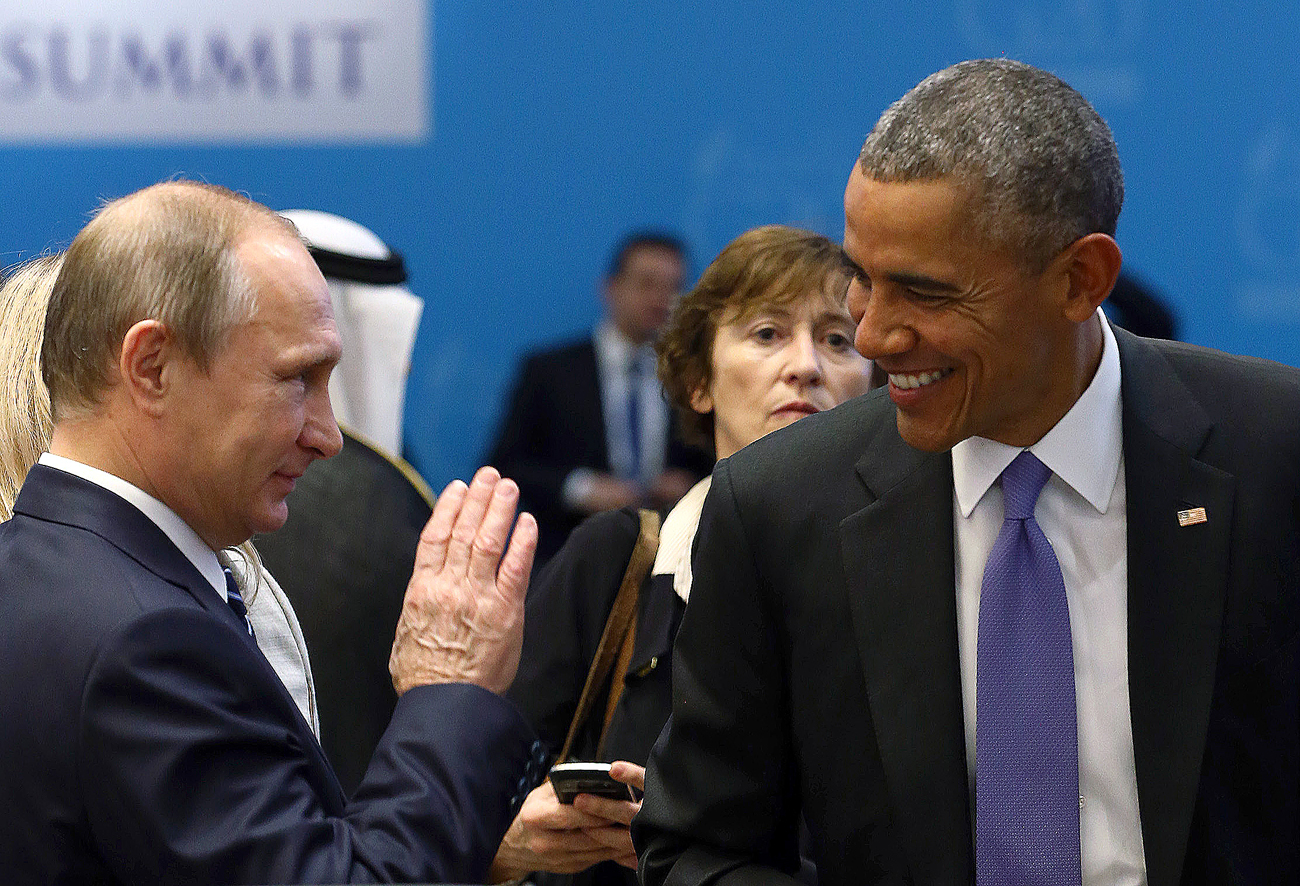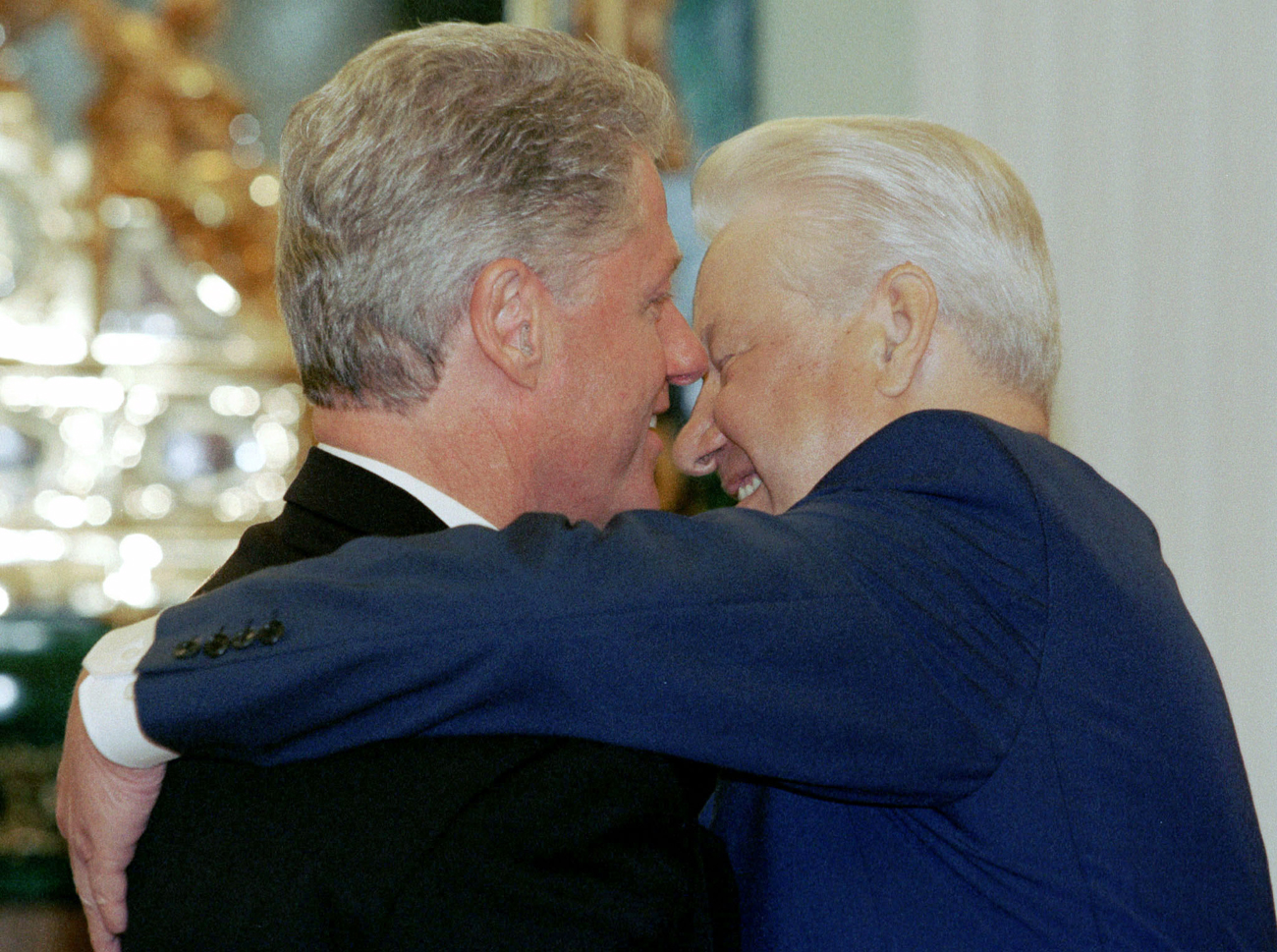
U.S. President Barack Obama (R) chats with Russia's President Vladimir Putin prior to a working session at the Group of 20 (G20) leaders summit in the Mediterranean resort city of Antalya, Turkey.
ReutersMoscow and Washington are used to trading accusations. However, the mood prevalent today is reminiscent of truly dark periods in relations between the two countries. The U.S. State Department’s official spokesman promises Russia new losses in Syria, while the Russian Defense Ministry reminds U.S. “strategists” of the effective range of the S-300 and S-400 missile systems deployed near the Khmeimim air base.
The news media coverage is close to the worst examples of the early 1980s and, in some sense, is even worse.
Back then, the sides at least did not ape each other, whereas now it is sometimes not clear where trolling ends and threats begin, and vice versa. So what’s next?
In order not to despair altogether, it is worth pointing out that, generally speaking, the trajectory of Russian-U.S. relations since the Cold War has in fact been very stable. It is linked to electoral cycles, inside which there may be fluctuations, but by the end of yet another cadence there comes an inevitable rise in tensions.
“Bill Clinton thought it possible to put pressure on Russia. He must have forgotten, for a second, for a minute, for half a minute, what Russia is and that Russia possesses the full arsenal of nuclear weapons,” said Boris Yeltsin during a visit to Beijing in early December 1999.
“Clinton decided to flex his muscles. I would like to say to Clinton through you: He should not forget what kind of world he is living in. It has never been the case and will not be the case that he alone dictates to the world how to live. A multipolar world is the basis of everything. As we have agreed with Chinese leader Jiang Zemin: We shall be dictating to the world, and not he alone.”
Yeltsin’s resignation was less than four weeks away and that statement, in effect, drew a line under the eventful relations between the two countries and the two presidents (who officially referred to each other as friends) in the 1990s.
Yeltsin’s tough-worded reaction came in response to Clinton’s remark that Russia would “pay dearly” for its actions in Chechnya – the West was preparing sanctions.
Interestingly, it was Russian Prime Minister Vladimir Putin who back then had to defuse the situation, firstly by saying that Yeltsin’s statement was not seeking to worsen relations between Moscow and Washington.
Furthermore, and even more interestingly, Putin stressed: Bill Clinton’s criticism of the Chechen campaign must have been caused by his concern that Russia might end up with additional problems. The reaction from the Americans – Clinton himself and his official spokesman – was dismissive: One should not pay attention to what the Russian president said.
 Russian President Boris Yeltsin (R) hugs U.S. President Bill Clinton before their talks at the Kremlin. Source: Reuters
Russian President Boris Yeltsin (R) hugs U.S. President Bill Clinton before their talks at the Kremlin. Source: Reuters
That episode contains everything that we are seeing today, albeit in a milder form. A warning to Russia about punishment for its “wrong” behavior, an extremely heated response with a reminder of Russia’s military potential, the United States’ unwillingness to take it seriously. It is symbolic that Yeltsin made that threatening statement while in China, as if appealing to the influence of that powerful neighbor. It does look like a blueprint for the current ‘entente cordiale’ between Moscow and Beijing.
That said, between 1993 and 1998, Washington, and Bill Clinton personally, acted as the main patron of the “young Russian democracy” and seemed to have taken a lot of effort to bolster relations. However, mutual irritation was mounting. In August 1998, Russia defaulted on its debts, as a result of which foreign stock market players lost quite a lot of money and were very angry.
In the winter and spring of 1999, NATO’s first expansion took place and the bombing of Yugoslavia began. In reaction to the collapse of the state treasury bills pyramid, Western media launched a major campaign against “Russian kleptocracy” (the Bank of New York case and the alleged laundering of Russian mafia money). The war in Yugoslavia, which Moscow could not either prevent or stop, led to a strategically pointless but headline-grabbing stunt with the dispatch of Russian paratroopers to Pristina airport in Kosovo. Thus, the Beijing invective was the culmination of a whole series of events.
George W. Bush arrived at the White House as an antipode to Clinton, just as Vladimir Putin was seen as an opposite to Yeltsin. Nevertheless, the same pattern emerged, only with even greater fluctuations. The two leaders set off with mutual rapport at their first meeting in Ljubljana, followed by a dramatic boost in September 2001, when Russia and the U.S. ended up being almost allies in the war on terror.
What followed were intensive contacts with dramatic ups and downs: Chechnya, Washington’s withdrawal from the ABM treaty, the Russia-NATO Council, Iraq, the “Rose Revolution” in Georgia, the first “Maidan” uprising in Ukraine, the decision to deploy missile defense in Eastern Europe, Kosovo…
The atmosphere was growing darker, trust was shrinking, however, in April 2008, close to the end of Vladimir Putin’s second term, there came the summit in Sochi and the signing of the strategic framework declaration. In that document, the sides tried to calmly list all the areas that presented mutual interest (thus, in effect, laying the foundation for the whole agenda of the future reset in relations, credit for which later went to the countries’ subsequent presidents, Barack Obama and Dmitry Medvedev). The two leaders parted on a reconciliatory and even warm note.
Four months later (Bush was still president, while Putin was already prime minister) came the Russian-Georgian war, and Russian-U.S. relations fell to their lowest point since the Cold War.
Hotheads in Washington were calling for bombing the Roki Tunnel between Russia and Georgia, while Moscow was convinced that it was in fact fighting not with Georgian President Mikheil Saakashvili but with Bush.
It seemed that everything was over and the White House would soon be occupied by John McCain, the epitome of a hawkish approach. But then came the collapse of Lehman Brothers and the global financial crisis, and nobody could care less about Russia.
Under Obama, another attempt to travel along the same route was made. An announced detente with Russia (though incidentally, the translation error made in spring 2009 when Hillary Clinton presented Russian Foreign Minister Sergei Lavrov with a mock “reset” button which said, in Russian, “overload” rather than “reset,” now looks oddly prescient) led to rapport between Medvedev and Obama, active work on the START agreement, the suspension of missile defense plans, talks on Iran, and Russia’s membership of the WTO. Yet all this now stands against the backdrop of the Arab Spring, Libya, growing disagreements on Syria, Vladimir Putin’s return to the presidential post, surprises like Edward Snowden, Ukraine, Syria again – this time head-on …
One cannot fail to notice that the end of each new cycle is more acute and dangerous than the previous one.
In 1999 – an oral reminder of “what Russia is.” In 2008 – the first talk of proxy military confrontation and a show of strength in the Black Sea. In 2016 – two air force armadas in immediate proximity of each other, with a risk of a direct clash and unforeseen escalation.
The media coverage is such that the 1999 accusations of “Russian mafia” now sound like baby talk – it has not yet reached the “empire of evil” level, but the “evil emperor” has already been appointed.
Russian-U.S. relations, of course, depend on the personalities involved. The fact that it was under Obama that they reached their lowest point is understandable. The incumbent U.S. president always puts himself in the center (hence, his love of external effects and striking statements with little substance behind them) and does not think it necessary to build relations with people, be they opponents or allies. The Americans also see the cause in one specific individual, painting the Russian president as a demon on a universal scale.
However, this all stems, of course, not from the “chemistry,” or lack thereof, between the leaders (Putin and Bush did have this) but from what Boris Yeltsin spoke about in Beijing in December 1999. Structurally, Russia has never been prepared to fit into a world governed by America, but it has never had strength enough to challenge it in earnest. Meanwhile, America has never had enough strength to build that world for real, but it is not prepared to give up on that idea either.
The cyclical, step-by-step, deterioration of the situation has now brought things to a really dangerous brink and the reason for it is that the world order model as envisaged 25 years ago has fully exhausted itself.
The question now is how the transition will go – and to what. In the meantime, the U.S. election really cannot come too soon. Whoever wins, there will at least be some breathing space.
It is emblematic that the popular fairground attraction for thrill-seekers, the rollercoaster, is known in Russia as “American Mountains” and in the U.S. as “Russian Mountains.” The thrill is the same, but the causes are seen as deriving from the other side’s peculiar features – just the same as in politics.
Fyodor Lukyanov is editor-in-chief of Russia in Global Affairs magazine and chairman of the Presidium of the Council on Foreign and Defense Policy, an independent Moscow-based think tank.
The opinion of the author may not necessarily reflect the position of RBTH or its staff.
First published in Russian by Gazeta.ru
All rights reserved by Rossiyskaya Gazeta.
Subscribe
to our newsletter!
Get the week's best stories straight to your inbox